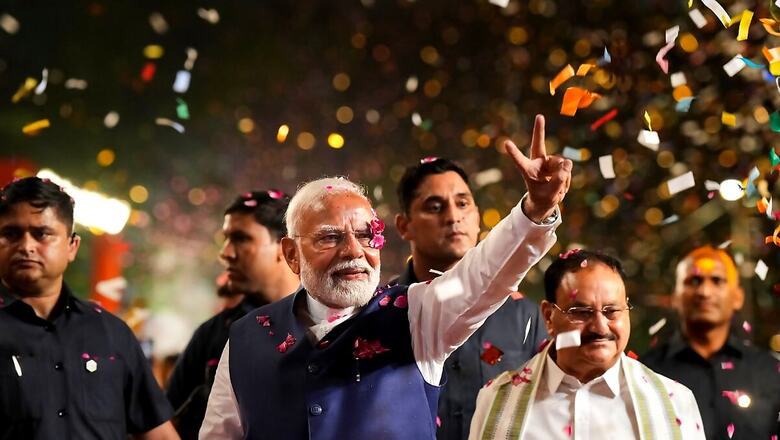
views
Having secured a momentous third term with a clearly outlined vision, Prime Minister Narendra Modi’s overarching legacy, according to a new book, will be that of transforming his party into an electoral machine, a party that can win elections.
‘Indian Renaissance – The Modi Decade’ (Westland Books), edited by Aishwarya Pandit, argues that Modi’s biggest contribution lies in dismantling a perception that the BJP, being a purely ideological party, had no mass base. “Modi is responsible for making the party and the RSS’s ideology palatable to a larger audience, both within and outside the country. The party’s ideology, which was seen as unsuited for the push and pulls of national and regional politics, had been a limiting factor to its growth so far. However, Modi has achieved the unthinkable by making the BJP hegemonic, commanding the narrative of elections and development, and ushering in a dynamism into the office of the prime minister that has few parallels across the world,” writes Pandit.
‘Indian Renaissance: The Modi Decade’ features essays by prominent figures including Tony Abbott, Samir Saran, Penny Street, Don Ritter, Rajiv Kumar, Avatans Kumar, Grant Newsham, Cleo Paskal, Kartikeye Sharma, Priya Sahgal, M D Nalapat, and others.
In her essay, Pandit, who teaches legal history at Jindal Global Law School, OP Jindal Global University, makes an interesting observation. She notes that each time election results have been announced since 2014, the prime minister has visited the central party headquarters to congratulate and interact with his karyakartas. “His messaging is clear; he is speaking directly to his cadres who form the backbone of the party. Modi has communicated that the party comes first,” Pandit argues. She emphasises this point by describing his visits to the party office: “He reinforces it every time… reminding workers that no matter how complete and stupendous a victory you may achieve, no individual—not even him, despite being the prime minister—is higher than the party. This is the enduring legacy he will leave behind: strengthening not only the party but the belief that the party is supreme.”
To substantiate her argument, Pandit cites Modi’s 2019 victory speech to party cadres: “We the workers of BJP, our friends in NDA, we dedicate the victory at the feet of the people… Just like what our president said, the crores of BJP workers, their efforts and the purpose—I feel so proud that my party, which I am a part of, is full of generous people… We have to accept the election results with humility. A government is formed with the people’s mandate, and we have to work with the spirit of inclusion.”
Pandit reminds readers that Modi inherited a BJP with no clear vision, a party unable to recover from the debacle of 2009. The loss had demoralised the cadres—and more so the RSS, which many believe decided to fully back the then Chief Minister of Gujarat, Narendra Modi, in 2002.
Fighting the battle of perception had been a monumental task for Modi, as the BJP was seen as an ideological party with little to offer beyond expanding its base to urban voters in small towns and capital cities in India. This was a daunting challenge, as previous leaders were constrained by a limited support base and had to contend with coalition partners, which nearly brought down governments. Modi’s expansion of the BJP’s base beyond caste, community, and religion will be his enduring legacy, as the pressures of national politics have been very different from those of being the chief minister of Gujarat.
Pandit succinctly argues that Modi, in certain respects, has captured the imagination of Indians much like Kennedy did for Americans. Modi’s entry onto the political scene coincided with the explosion of social media. The period between 2014 and 2024 was marked by heightened international tensions. The rise of ISIS in 2014, the Iranian nuclear programme and climate change crisis, the 2020 global pandemic, and the Russian invasion of Ukraine are just some of the events that have contributed to this climate. It became clear early on that the social media revolution ushered in by the digital revolution presented unprecedented challenges.
During Manmohan Singh’s term, social media was at best peripheral to mainstream media, but Modi used it extensively for citizen outreach in Gujarat, as noted by Andy Marino in his unofficial biography of Modi. As prime minister and BJP icon, Modi has successfully used social media to communicate with voters of every age and region. This also encouraged his party to use social media extensively, resulting in many debates on the platform being led by the BJP.
However, there is a flip side. The primacy and focus on social media have altered the mode and manner of communication. In fact, Modi has allowed social media to operate freely, fully aware of the potential long-term dangers it poses for him. The proliferation of YouTube channels has enabled a variety of opinions to coexist in what was previously a domain largely controlled by a few—primarily legacy media channels.
The writer is a Visiting Fellow at the Observer Research Foundation. A well-known political analyst, he has written several books, including ‘24 Akbar Road’ and ‘Sonia: A Biography’. Views expressed in the above piece are personal and solely that of the author. They do not necessarily reflect News18’s views.


















Comments
0 comment